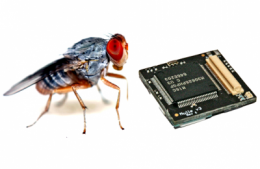Inspired by insect intelligence

Monash University researchers, as part of an international collaboration, are using insect intelligence to develop new wireless sensor networks that could transform how we monitor changes to the environment, buildings and infrastructure, and patient health.
It all began with a study on fruit flies, explained Dr. Asad Khan, Senior Lecturer from the Faculty of Information Technology.
“When it comes to energy efficiency, fruit flies can teach us a lot,” Dr. Khan said.
“A fruit fly’s brain consumes only a few microwatts of power, and yet is still able to integrate sensory information, actions of flight, and control over relatively complex behaviour in order to survive.”
“Conventional computers are no way near as efficient. An average computer sensor node consumes about one milliwatt of power, which is around a thousand times more than that used by a fruit fly.”
Using a process known as ‘bio-inspired computing’, the research team is studying the efficiencies and intelligence of biological systems, such as the brain function of the fruit fly, to develop new wireless sensor networks (WSN).
A typical WSN consists of sensors, numbering from a few to several thousand, which register changes to physical stimulus, such as light, temperature, heat and sound. Information from the sensors is processed at nodes, which then send or receive data from a central computer ‘brain’ that controls the network.
“WSN are hugely important and widely used to monitor patient health, track air pollution and as early detection systems for forest fires,” Dr. Khan said.
“The exciting thing is that bees and fruit flies receive and process the same kinds of sensory information transmitted by WSN. So what we are doing is taking the lessons from how insects function and applying this knowledge as new design principles to create much more powerful and efficient computer networks.”
“Using this bio-inspired approach it may be possible to create infinitely scalable WSN that could include not just thousands, but millions of sensors.”
Dr. Khan said the development of WSN technology could have far-reaching implications for much larger networks accessible online, with several major computing companies predicting that billions of sensor devices could be connected to the Internet within the next decade.
“It is very exciting that Monash is supporting pioneering research into advanced computing technologies that, while currently untested, have the potential to transform how we monitor and manage just about anything, in ways we can scarcely imagine,” Dr. Khan said.
Provided by Monash University















